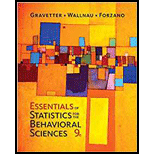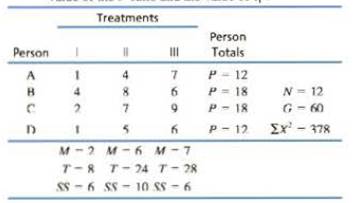
Concept explainers
The following data are from a repeated-measures study comparing three treatment conditions.
- a. Use a repealed-measures ANOVA with α – 05 to determine whether there are significant differences among the treatments and compute η’ to measure the size of the treatment effect.
- b. Double the number of scores in each treatment by simply repeating the original scores in each treatment a second time. For example, the n = 8 scores in Treatment I become 1.4, 2.1, 1.4, 2.1. Note that this will not change the treatment means but it will double SSbetween treatments, SSbetween subjects, and the SS value for each treatment. For the new data, use u repeated-measures ANOVA with α - 05 to determine whether there are significant differences among the treatments and compute η’ to measure the Size of treatment effect.
- c. Describe how doubling the
sample size affected the value of the F-radio and the value of η’.
a.
To compute: The value of
Answer to Problem 11P
There are significant differences between the treatments. The value of
Explanation of Solution
Given info:
Following data are from a repeated-measure study comparing three treatments conditions.
| Treatments | |||||
| Person | I | II | III | Person totals | |
| A | 1 | 4 | 7 |
|
|
| B | 4 | 8 | 6 |
|
|
| C | 2 | 7 | 9 |
|
|
| D | 1 | 5 | 6 |
|
|
|
|
|
|
|||
|
|
|
|
|||
|
|
|
|
|||
Calculation:
The hypotheses are given below:
Null Hypothesis: There are no differences among treatments.
Alternate Hypothesis: There are significant differences among the treatments.
Let k and n represents the total numbers of treatments and participants. Then,
Let, N represents total numbers of observations. Then,
Degrees of freedom corresponding to
Degrees of freedoms corresponding to
F-ratio is given as:
From the table
Since, F-ratio is greater than the critical value; therefore, reject the null hypothesis and conclude that there are significant differences between the treatments.
Conclusion:
There are significant differences between the treatments. The value of
b.
To compute: The value of
Answer to Problem 11P
There are significant differences between the treatments. The value of
Explanation of Solution
Calculation:
The new data is obtained by doubling the number of scores in each treatment by simply repeating the original scores in each treatment a second time.
The hypotheses are given below:
Null Hypothesis: There are no differences among treatments.
Alternate Hypothesis: There are significant differences among the treatments.
Let k1 and n1 represents the total numbers of treatments and participants of the new data. Then,
Let, N1 represents total numbers of observations of new data. Then,
Degrees of freedom corresponding to
Degrees of freedoms corresponding to
F-ratio is given as:
From the table
Since, F-ratio is greater than the critical value; therefore, reject the null hypothesis and conclude that there are significant differences between the treatments for the new data.
Conclusion:
There are significant differences between the treatments. The value of
c.
Answer to Problem 11P
The F-ratio got increased and there is no effect on
Explanation of Solution
Given info:
Sample size has been doubled.
Calculation:
From part a. the F-ratio is
After doubling the sample size, from part b. the F-ratio is
But value of
Conclusion:
The F-ratio got increased and there is no effect on
Want to see more full solutions like this?
Chapter 13 Solutions
Essentials of Statistics for The Behavioral Sciences (MindTap Course List)
- The following data were obtained from a repeated-measures study comparing two treatment conditions. Use a repeated-measures ANOVA with α = .05 to determine whether there are significant mean differences between the two treatments. Treatments Person I II Person Totals A 3 5 P = 8 B 5 9 P = 14 N = 16 C 1 5 P = 6 G = 80 D 1 7 P = 8 ΣX2 = 500 E 5 9 P = 14 F 3 7 P = 10 G 2 6 P = 8 H 4 8 P = 12 M = 3 M = 7 T = 24 T = 56 SS = 18 SS = 18arrow_forwardfrom the image, The following data summarize the results from an independent-measures study comparing three treatment conditions. Use an ANOVA with α = .05 to determine whether there are any significant differences among the three treatment means. a. State the null and alternative hypotheses. b. Locate the critical region. F = ? c. Calculate the test statistic. F = ? d. what is the correct decision?arrow_forwardAn experiment compares two conditions with a sample ofn = 20 in each treatment treatment. If the data are analyzed with ANOVA, the analysis would have dftotal O A. 18 О В. 19 O C. 38 O D. 39arrow_forward
- make it so i could copy and paste itarrow_forwardHere are data from an experiment studying the effect of age on creativity scores: Age 4 Age 6 Age 8 Age 10 3 9 9 7 5 11 12 7 7 14 9 6 4 10 8 4 3 10 9 5 Compute Fobt and create an ANOVA summary table. What do you conclude about Fobt? Perform post hoc comparisons if appropriate. What should you conclude about this relationship? How important is age in determining creativity scores?arrow_forwardA normal population has a mean of μ = 25 on a communication effectiveness scale. After receiving a treatment, a sample of n = 4 scores yields the following data: 20, 28, 20, 20. Is there evidence for a significant treatment effect? Use an alpha level of .05.arrow_forward
- 5.75 Binge drinking. The Centers for Disease Control and Prevention finds that 28% of people aged 18 to 24 years binge drank. Those who binge drank averaged 9.3 drinks per episode and 4.2 episodes per month. The study took a sample of over 18,000 people aged 18 to 24 years, so the population proportion of people who binge drank is very close to p = 0.28.23 The administration of your college surveys an SRS of 200 students and finds that 56 binge drink. (a) What is the sample proportion of students at your college who binge drink? (b) If, in fact, the proportion of all students on your campus who binge drink is the same as the national 28%, what is the probability that the proportion in an SRS of 200 students is as large or larger than the result of the administration's sample? (c) A writer for the student paper says that the percent of students who binge brink is higher on your campus than nationally. Write a short letter to the editor explaining why the survey does not support this…arrow_forwardSocial Media Use and ADHD. Exercise 2.23 introduces a study examining whether frequent use of digital social media by teens is associated with subsequent development of ADHD symptoms. Researchers rated the frequency of social media use as High or Low for each teen. Two years later, they recorded whether or not ADHD symptoms had been diagnosed. The results are shown in the table below. Use StatKey or other technology to test whether the proportion of teens being diagnosed with ADHD is higher for teens with a high frequency of social media use than for those with a low frequency. Show all details of the test. Let Group 1 represent the teens with high social media use and Group 2 represent those with low social media use. State the null and alternative hypotheses. Give notation of the sample statistic. Give value of the sample statistic accurate to three decimal places. Use a randomization distribution to find the p-value. Give your answer accurate to three decimal places. Social…arrow_forwardThe following data were obtained from a two-factor independent-measures experiment with n = 5 participants in each treatment condition. What is the value for the mean squares for Factor B B1 B2 B3 A1 M = 3 T = 15 SS = 18 M = 6 T = 30 SS = 28 M = 9 T = 45 SS = 26 A2 M = 1 T = 5 SS = 8 M = 4 T = 20 SS = 20 M = 1 T = 5 SS = 20arrow_forward
- 6. Binge-watching a television show might not be the best way to enjoy a television series (Horvath et al., 2017). Participants in an experiment were in a group that either watched an entire tv series during daily one-hour sessions or watched all the episodes during a single binge session. Participants were asked to rate their enjoyment of the t.v. series on a scale of 0-100. Data like those observed by the author are listed below: Binge-watched 87 Daily-watched 84 71 100 73 87 86 97 78 92 a. Is there a difference in the level of enjoyment based on whether the series was binge-watched or watched on a daily basis? Use a two-tailed test at the a = 0.05 level of significance? b. Do the data analysis in SPSS in addition to your hand calculations. Attach a printout of your results.arrow_forwardThe following data were obtained from a repeated-measures study comparing two treatment conditions. Use a repeated-measures ANOVA with α = .05 to determine whether there are significant mean differences between the two treatments. Calculate η2 as a measure of effect size. State the results as they would appear in a research report.arrow_forwardThe following data represent the results from an independent-measures study comparing two treatment conditions. Use an independent-measures t test with α = .05 to determine whether there is a significant mean difference between the two treatments. Use an ANOVA with α = .05 to determine whether there is a significant mean difference between the two treatments. Treatment I II 8 2 N = 10 7 3 G = 50 6 3 ΣX2 = 306 5 5 9 2 M = 7 T = 35 M = 3 T = 15 SS = 10 SS = 6arrow_forward
 Glencoe Algebra 1, Student Edition, 9780079039897...AlgebraISBN:9780079039897Author:CarterPublisher:McGraw Hill
Glencoe Algebra 1, Student Edition, 9780079039897...AlgebraISBN:9780079039897Author:CarterPublisher:McGraw Hill
